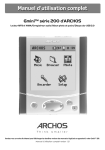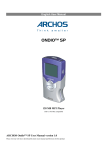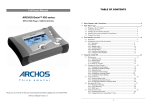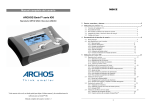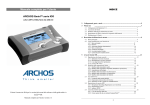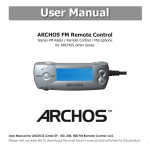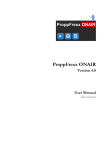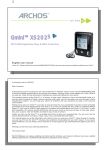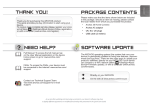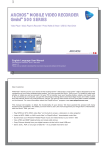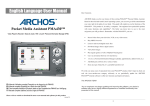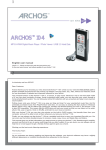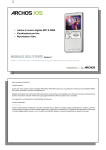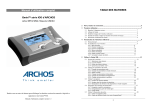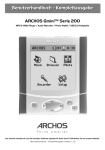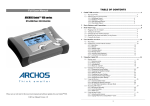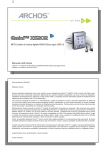Download Full User Manual
Transcript
Full User Manual ARCHOS Gmini™ 200 series MP3 & WMA Player / Audio Recorder / Photo Wallet / USB 2.0 Hard Disk Please see our web site for the most recent manual and software updates for your Gmini™200. Full User Manual Version 1.21 1 6 Using MusicMatch™ Table of Contents 1 Ports, Buttons and Connections 4 2 First Time Usage 7 2.1 Plugging in the AC Adapter 2.2 Turning on the Gmini 2.3 Changing the user interface language 2.4 Shutting off the Gmini and Battery saving features 2.5 Caring for the Gmini 7 7 7 8 8 3 User Interface Overview 9 3.2.2 Browser 9 4 with your Gmini 37 38 8.1.1 Downloading the .AOS file 38 8.1.2 Read the History Text File 38 8.1.3 Copy to Gmini Root Directory 38 9 Troubleshooting 39 39 41 3.2.3 Settings screen 10 3.2.4 Contextual Menus 10 9.2.1 Windows® 98SE & ME Running Scan-Disk (Error Checking) 42 3.2.5 Message boxes 11 9.2.2 Windows® XP & 2000 Running Check Disk Utility (ChkDsk) 42 3.2.6 Using the Virtual Keyboard 11 3.2.7 Locking the Gmini Buttons 11 12 4.1 Playing music 12 4.1.2 Playing a song 12 4.1.3 Using Playlists 14 4.1.4 What is an .m3u file? 15 43 11 Technical Support 44 16 4.2.1 Changing the Sound Settings 16 4.2.2 Changing the PlayMode Settings 17 4.2.3 Setting the Clock 18 4.2.4 Changing the Power Settings 19 4.2.5 Changing the Recording Settings 20 4.2.6 Changing the System Settings 21 4.3 Using the Browser 22 4.3.1 Inside the MUSIC Folder 22 4.3.2 Navigating the Directory Structure 22 4.3.3 File and Folder Operations in Browser Mode 23 4.4 Recording MP3 Music 25 4.4.1 Microphone Recording 26 4.4.2 Line-In Recording 26 4.5 Using the photo wallet 27 27 4.5.2 Copying Files from a CompactFlash™ Card 27 4.5.3 Displaying Photos on the Gmini 27 5 Connecting the Gmini to your Computer 29 5.1 Making the USB Connection 29 5.1.1 Windows® ME/2000/XP and Macintosh® 9.2 or 10.2.4 and better 29 5.1.2 Windows® 98SE 29 5.2 Using the Gmini as an external drive 5.3 Disconnecting the Gmini from your Computer 31 31 5.3.1 Windows® 31 5.3.2 Macintosh® 32 Table of Contents 4.5.1 Using the photo browser 10 Technical Specifications 12 4.1.1 Selecting a song 4.2 Changing the Gmini Settings Table of Contents 36 iTunes® 9.1 USB Connection issues 9.2 File issues, corrupted data, formatting, and partitioning 4 Using the Gmini 200 2 35 6.4.2 Creating and Using Playlists with MusicMatch™ 8 Updating your Gmini Operating System (OS) software 9 9 3.2.1 Main menu 33 34 35 35 6.4.1 ARCLibrary Updating 7 Using 9 3.1 Main Menu 3.2 Familiarizing yourself with the interface 33 6.1 Installing MusicMatch™ 6.2 Creating MP3 files from your Audio CDs 6.3 Getting purchased MP3 files to your Gmini 6.4 The ARCLibrary and MusicMatch™ Playlists 3 1 Ports, Buttons and Connections 4 B Contextual Menu - When the menu icon available. appears in top left of screen, a menu is C Move Left - also decreases recording gain A Built-in microphone D Move Up - also, increases playing volume B Multi-connect Adapter Plug - allows for Line-In and Line-Out connections E Move Right - also increases recording gain C Headphone Multi-connect jack - To connect headphones, FM remote control, or adapter plug. F Play/Pause/Enter - Play current item, pause, play again. Enter value. G Stop/Esc button - Stop playing current file or escape from current screen. H Move Down - also decreases playing volume D Photo Wallet Port (CompactFlash™ type I & II) Ports, Buttons and Connections Ports, Buttons and Connections A Power button - Hold down for a few seconds and the Gmini will start up. 5 2 First Time Usage Please understand that this device has a CPU, hard drive, and Operating System (OS) and thus it is more like a computer than a CD player, cassette player, or radio. If you are not familiar with using a computer, it would be particularly useful to read through this detailed User Manual. 2.1 Plugging in the AC Adapter Before using your Gmini 200 for the first time, completely charge the internal batteries. • Use ONLY the included ARCHOS charger/adapter. The ARCHOS charger/ adapter has a special USB tip which you will plug into the USB port. Charging will start automatically when it is plugged in. • The batteries are fully charged when the full battery icon appears. Empty battery: The battery is uncharged. It must be charged. 6 2.2 A Mini USB 2.0 port (USB 1.1 compatible) After the first initial full charge, you may use the Gmini while the AC adapter is plugged in. Turning on the Gmini • Hold down the POWER button until the screen comes on, then let off. • If your Gmini is charging, click the PLAY button to turn it on. • If the Gmini shows an empty battery icon or if the Gmini displays nothing at all, you will have to plug in the Archos adapter/charger to make sure the batteries get charged. B USB Power Adapter C Power – To power the unit and charge the internal batteries with the AC adapter. Full battery: The battery is completely charged and the AC adapter can by unplugged. 2.3 Changing the user interface language English is selected as the default language for your Gmini user interface. You can choose another language as explained in chapter 4.2.6. First Time Usage Ports, Buttons and Connections • Animated battery: The battery is currently being charged. 7 2.4 Shutting off the Gmini and Battery saving features • To shut off the unit, press and hold the POWER button for 3 seconds. • If left idle, the screen’s blue backlight will shut off after 20 seconds in order to save battery power. After 30 seconds, the screen display will shut off, also to save energy. Finally, the Gmini will shut itself off completely after 3 minutes if left idle and no music is playing. You can change these settings under [Setup Power]. 2.5 3 3.1 User Interface Overview Main Menu Once the Gmini has been turned on, the following screen is displayed. This is the main menu screen from which you can select the main functions. Caring for the Gmini The Gmini is an electronic product that needs to be treated with care. • Do not subject it to shock. You may however go jogging with it or do sports. • Do not subject it to heat. Keep it ventilated. Be careful that the surface it is on, is a flat clear surface. Placing the Gmini on a pillow, blanket, carpet, or wrapped up to protect it will restrict the necessary ventilation that it needs. This increase in operating temperature may cause damage to the device. • Keep the Gmini away from water and excessively humid areas. • Keep the Gmini away from high electromagnetic fields. • Keep it plugged into the Archos AC adapter/charger when it is connected to your computer. 3.2 • Music: browse through your music files or use the ARCLibrary music selection system. • Browser: browse through and manage all the files on your Gmini. • Photo: display photos (JPEG) and view photo information. • Recorder: record from any music source (Stereo, portable players, etc.) or from the built-in microphone. • Setup: set the parameters of your Gmini to your personal taste. Familiarizing yourself with the interface 3.2.1 Main menu Each icon corresponds to a mode. Use the LEFT, RIGHT, UP and DOWN buttons to navigate from one icon to another. Press OK to select the icon and start the action. Press Esc to exit. First Time Usage Use the UP and DOWN keys to highlight the item of your choice. If you keep pressing UP or DOWN, the list will scroll for you to see the other items. The vertical black indicator on the right shows your relative position in the entire list. 8 Press OK to start the action corresponding to the highlighted item. User Interface Overview 3.2.2 Browser 9 3.2.3 Settings screen 3.2.5 Message boxes Selectable items: use the LEFT and RIGHT keys to change the parameter value. The new value is immediately taken into account so there is no need to press OK. Click on ESC when done. Check boxes: each checkbox corresponds to a different parameter value but only one parameter can be selected at a time. Use the UP and DOWN keys to highlight an item and then press OK to validate it. Click on ESC when done. Actions: in the settings screens you sometimes need to perform some actions. Actions are shown enclosed with [ ]. Press OK to start the action. From time to time a message box is displayed on the screen. This may be a warning or an error message, or a question to confirm an action. Message boxes may have up to 3 buttons (for instance yes, no and cancel). If there is more than one button use the left and right keys to highlight the button you want. In all cases press OK to validate your choice which will then exit the message box. 3.2.6 Using the Virtual Keyboard It is recommended that you create folders and rename files or folders from your computer when it is connected to the Gmini. The computer keyboard is easier to use. Often times, however, you are not near your computer and you would like to enter the text directly with the Gmini. For this, you will use the virtual keyboard. You will be taken to this screen when you rename a file or folder or when you name a recording. Contextual Menu Current text being typed Cursor Back Space* Clear the entire line* 10 Enter* When the menu icon is present on the top-left corner of the screen you can press the MENU button to display a popup menu with actions related to the current mode. Pressing MENU again or ESC closes it. * these items can also be found in the contextual menu Use the UP and DOWN keys to highlight the action you want to start and then press OK to validate it. Tip: use the ESC key to cancel any changes you made and exit the virtual keyboard. You will use the LEFT, RIGHT, UP and DOWN buttons to move around the keyboard. Click on OK/PLAY to enter the character that is highlighted. Once satisfied with your text entry, click on the MENU button and select Enter. 3.2.7 Locking the Gmini Buttons You can prevent the Gmini from executing unintended functions by locking the buttons. To lock the buttons, hold down on the MENU key until the “lock” icon appears in the top-left corner of the screen. Now all buttons except the MENU key are disabled. To unlock the buttons hold down again on the Menu key until the “lock” icon disappears. User Interface Overview User Interface Overview 3.2.4 Contextual Menus Toggle between uppercase and lowercase characters* 11 4 4.1 Using the Gmini 200 Menu available Status: Paused Play Mode: One Directory Play Order Volume Time of Day Playing music 4.1.1 Selecting a song There are two ways to access your music. You can either access your songs by browsing through the folders, where you keep your music files, or you can choose from Artist, Album, Genre, or Song. Artist* or parent folder Song title* or file name Album* or current folder File format and recording information Battery level Right and Left VU Meters Song elapsed time Song time remaining Song Length *If the MP3 file contains these ID3 tag data Browsing through the folders Click the OK/PLAY button on the highlighted “Browse hard drive”. You will be sent directly to the Music folder of your Gmini. This is a filtered access to browse the hard disk. Here you can look at all your music files and the folders on your Gmini’s hard drive as if you were browsing files with a computer. You will only see audio files types that are playable on the Gmini (MP3, WMA, WAV). To select a file you can use the UP and DOWN keys to move upwards or downwards and OK to enter a highlighted subfolder. See chapter 4.3 for more information about using the Browser. Play Status Play Order Stopped (no icon) Play once Playing a track Shuffle (Random) track selection Current track is paused Repeat playing Recording a track Play Mode 12 Using the ARCLibrary System Folder: Play all tracks in the current directory You can search your music by artist, album, song name, genre. Use the UP/DOWN buttons to scroll to your selection and then click on OK. Once one of these is chosen, you will see an alphabetical list. You can now choose the Album, Artist, or song Title (depending which search type you started) that you desire. If you add music to your Gmini, you will need to use MusicMatch™ to update the ARCLibrary in order for it to take into account the newly acquired music. See section 6.4.1 for details. All: Play all tracks on Gmini Single: Play a single track then stop Queue: User can queue the next track to be played Scan: Gmini plays first 15 seconds of each track Playback contextual menu • Setup: displays the setup screen (same as selecting the Setup icon in the main menu) • Edit Playlist: enters the playlist editor (see below for how to use playlists). • Browser: allows to browse through your files while playing. 4.1.2 Playing a song When you get to your desired song, click on PLAY/OK. If you hear nothing at first, make sure you have adjusted the volume control on the headphone cord. Using the Gmini 200 Using the Gmini 200 Playlist: Gmini is currently playing from a Playlist 13 4.1.3 Using Playlists Playing a Playlist A Playlist is a list of songs that the Gmini will automatically play one after the other. The Gmini can handle one Playlist at a time. You can create new Playlists, add or delete songs from a Playlist, or Save a Playlist as a file (file type .m3u) to be used another time. There is no limit to the number of Playlists you can save on the Gmini hard drive. Creating a new Playlist To create a Playlist, press the RIGHT button while you are in the Music browser. A second panel is opened on the right side to display the Playlist contents (shown empty in the picture). You can now start adding songs to the current Playlist. In the left window, search for the songs you would like to add to your Playlist. Once the song is highlighted, click on the OK/PLAY button to add it to the Playlist. The song will be added to the Playlist and a small mark is placed next to the music note icon to indicate that it is now in the Playlist. Continue searching and adding songs in this manner until you are satisfied. You can jump back and forth anytime between the two windows by clicking the LEFT/RIGHT buttons. A Playlist can have a maximum of 1000 songs in it. We recommend that you save your Playlists to the Gmini hard drive (see below) to be used again later. You can also add all the music files of a complete folder in one operation by highlighting the desired folder, pressing MENU to display the contextual menu, and then selecting either ADD TO PLAYLIST or INSERT TO PLAYLIST. Watch which window you are in since the left window menu has different options than the right window menu. There are two ways to play a Playlist. 1) Press the RIGHT key to go into the Playlist edition window. Then use the UP and DOWN keys to select which song you want to start with. 2) In the Playlist window press MENU to display the contextual menu and select START PLAYLIST. The Gmini starts playing from the first track of the playlist. Playlist contextual menu description • Start Playlist: starts playing the first track of the playlist. • Save Playlist: saves the current Playlist onto the hard drive so that it can be reloaded later. It will be saved into the directory which is open in the left window. You should navigate in the left window to your Playlist folder before saving. • Rename Playlist: changes the name of the current Playlist with the virtual keyboard. • Shuffle Playlist: randomly changes the order of the items in the current Playlist . • Clear Playlist: remove all tracks from the current Playlist. • Move Track: changes the position of the current track within the Playlist. The current track is then displayed with a double arrow icon. Use the UP and DOWN keys to move the selected track and press OK to validate the new position. • Delete Track: removes the highlighted track from the playlist. Loading a Playlist 14 Important: Once you save a Playlist it is important that you do not move the actual MP3 files as the Playlist searches in the original file location. If you need to move your MP3 files to a different folder, you’ll have to recreate your Playlists. 4.1.4 What is an .m3u file? You can open a Playlist file (Playlistname.m3u) on your computer with a text editor such as Notepad or SimpleText (Macintosh®), and you will see that it is merely a list of files to be played along with the hard disk path to find them. If you delete a Playlist from Example of the contents of the .m3u Playlist your Gmini, you are only deleting the list and not the file ‘Jazz Music’ music itself. Because a Playlist includes the path to the music file (as shown in the example Playlist file above), you have to remember that if you change the location of a music file, then the path to it in the Playlist will be incorrect, and the Gmini will not play the song (because it can’t find it). Thus it is important to create a clean directory structure and not change where your files are located. Either that or just delete your Playlist and create a new one. Using the Gmini 200 Using the Gmini 200 You can load a previously saved Playlist or add the files it contains to the current Playlist. Use the music browser to select the Playlist of your choice (Playlists are indicated by a special list icon) and then press OK. If there were already some items in the Gmini Playlist, then the songs of the loaded Playlist will be added to the end of it. You can then check or modify the Playlist as usual in the Playlist window. 15 4.2 4.2.2 Changing the PlayMode Settings Changing the Gmini Settings There are a number of parameters you can set on the Gmini to make it operate according to your particular needs. Start by clicking on Setup. If you would like to customize the sound quality, go to [Setup Sound]. If you would like the Gmini to play through an entire folder of songs, play songs at random (shuffle), or any of the other playing options, you can set these parameters in the PlayMode settings. Go to [Setup PlayMode]. Parameter Parameter Volume Using the Gmini 200 All Play all tracks on the Gmini Single Play a single track then stop Queue User can queue the next track to be played † Scan Gmini plays first 15 seconds of each track †† Repeat and shuffle This parameter allows you to choose the order of play of your songs Balance Range: -5 to +5 (left to right) Rock, Techno, Jazz, Classic, Live or Custom [Set Equalizer] Allows to display the current equalizer or modify it (see below). [Reset] Sets all your sound parameters with default or flat values. Customizing the equalizer To set the equalizer, highlight the [Set equalizer] line and then click on OK. You will now be able to adjust the Gmini’s five band equalizer. Use the LEFT/RIGHT buttons to select a specific frequency range (Bass, Medium-Base, Medium, Medium-Treble, Treble) and then use the UP/DOWN buttons to increase or decrease the response for the given frequency range. Modifying these settings changes the sound in real time. Thus it is best to change these values while listening to a song. Normal: the music sequence is played once Repeat: the music sequence is played in a loop Range: 0 to 99 Controls the current volume. Change this parameter to select an equalizer setting to the style of music you are listening to. Select Custom to set your own equalizer levels. 16 Play all tracks in the current directory Description Sound effect Description Current Folder Shuffle: the music sequence is played randomly Bookmark The Bookmark, if set to On, will give you the option to mark your place in a music file, and return to it the next time you turn on your Gmini. While playing a song, click on PLAY/PAUSE to pause your song, and then on STOP. The Gmini will ask you if you would like to set a bookmark. Respond with Yes. The next time you turn on the Gmini, you will be asked if you would like to continue playing from your bookmark. If you respond «yes», the Gmini will continue from that place in the song you were previously at. †Queue Mode: While the current song is playing, click on the menu button and select Browse, find the next song you want to play, then click Play. This is your queued song. You can only queue one song at a time. See the Playlist section to prepare multiple songs to play. Once the current track is finished playing, your queued track will be played. If you do not queue another track at this time, the Gmini will play the next song in the directory. ††Scan Mode: Each track in the directory is played for 15 seconds. This allows a quick sample of each song. If you want to play the whole song, click on the Play button during those first 15 seconds. The Gmini will then revert to single directory mode and play the rest of the songs in the directory without scanning. Using the Gmini 200 4.2.1 Changing the Sound Settings 17 4.2.3 Setting the Clock 4.2.4 Changing the Power Settings If you would like to set the Gmini’s clock, go to [Setup Clock]. To help you get the most battery life out of your Gmini before having to recharge it, you can adjust the power settings. Go to [Setup Power]. Format Description This parameter tells how the time will be displayed on the Gmini screen: Parameter Power Off Using the Gmini 200 24h: displays hours from 0 to 23 18 1 to 31 Month 1 to 12 Year Set to the current year Hour 0 to 23 Minute 0 to 59 Second 0 to 59 [Set] You must select this to set the clock. Use the UP and DOWN arrows to choose which parameter to change, and then use the LEFT and RIGHT buttons to change that parameter’s value. When you have set all the values, MAKE SURE that you scroll down to the bottom and highlight the [set] parameter and then press OK to activate the time change. Click on STOP to escape back to the Setup screen. Range : 1 to 9 minutes or Never. Number of minutes of user inactivity before the Gmini automatically shuts off. The Gmini will not shut off during the playback of music files or during recording. Never indicates that the Gmini will not do an automatic shut down. 12h: displays hours from 1 to 12 Day Description LCD LCD display time : 10 to 90 seconds or Always. The time of user inactivity (no buttons pressed) before the Gmini turns off its LCD screen. Always indicates that the LCD screen will always stay on. Backlight Backlight shut down time : Off, 10 to 90 seconds, Always. The time of user inactivity (no buttons pressed) before the Gmini turns off the blue backlight. Always indicates that the backlight will always stay on. Keeping the backlight on will reduce the battery time. Contrast These values represent the black/white contrast of the screen. Using the Gmini 200 Parameter 19 4.2.5 Changing the Recording Settings 4.2.6 Changing the System Settings Each time you make a recording, either via the line-In or microphone, the Gmini has preset recording parameters that it will use. You can change these recording settings by going to [Setup Recording]. To change the system parameters or get some information about the system, go to [Setup System]. Description Set Title Allows you to set the Title ID3 tag in the MP3 file you will record Set Artist Allows you to set the Artist ID3 tag in the MP3 file you will record Set Album Allows you to set the Album ID3 tag in the MP3 file you will record Source Line-In, Mic. This allows you to choose the source of your recording. If you use the Line-In option, you must connect the multiconnect adapter plug to the multiconnect headphone jack, and then plug the audio source into the line-in jack of the adapter plug. If you use Mic, then you should speak into the built-in microphone. Format MP3 Determines the file format that will be recorded. The recordings are made as stereo 16 bit sampled sound. Using the Gmini 200 Line-in & FM Bitrate 20 Mic Bitrate Parameter Show all files If Off, the Gmini will only display the file names of files that it knows how to play. If set to On, the Gmini will display the names of ALL the files on the hard drive (using a ? icon for unknown types), even if they cannot be played, such as .tif or .pdf for example. This setting is important when the Gmini is used with the Photo Wallet software plug-in. Setting it to ON will allow the Gmini to transfer all the files from the CompactFlash™ card regardless of file type. If set to OFF, it will only read file types that the Gmini is capable of handling. ARCLibrary Off, On (default). Select Off to disable the ARCLibrary feature or On to enable it. Language English, Français, Deutsch. Use this to set the operating language of the Gmini. 32kb/s, 96kb/s, 128kb/s, 192kb/s. Allows you to set the recording quality of the line-in in terms of kilobits per second. The higher the value, the better the quality of the recording but also the more disk drive space that will be taken up. 128kb/s is equivalent to CD quality. During the recording, you can hear the quality of the recording from the headphones. Description Off (default), On. Product key Displays the product key of your Gmini 200. OS Version Displays the current version of the Operating System (OS). Hard Disk Displays amount of free space and used space of the Gmini hard drive. 16kb/s, 64kb/s, 96kb/s, 112kb/s. Allows you to set the recording quality of the microphone in terms of kilobits per second. The higher the value, the better the quality of the recording but also the more disk drive space that will be taken up. 64kb/s is a good level for most recording situations. During recording, it is normal that you will not hear your voice through the headphones. ATTENTION: changing the ARCLibrary parameter will only take effect after the next restart of the Gmini. Using the Gmini 200 Parameter 21 4.3 Using the Browser The browser is used to navigate the file system on the Gmini. The file system is the same type of file system that is found on Windows® based computers. This way, transferring files from your computer to your Gmini is as easy as ‘drag and drop’. The file system is a hierarchical system which includes folders and subfolders. Because you will be putting hundreds of files onto your Gmini, it is STRONGLY ADVISED that keep a neat and orderly file structure. Otherwise, you will be spending time searching for files and not listening to them. We suggest that on the first level of your file structure, you include the folders: Data (to carry miscellaneous data files with you), Music (all of your music files), Playlists (to hold all your music Playlists), Photo (for the files you copy from CompactFlash™ cards), and Voice (for microphone recordings). 4.3.1 Inside the MUSIC Folder The top level of your Archos Gmini includes the folder Music. Most people who create neat file structures for their Archos MP3 players make the following hierarchy within the Music folder. Button Controls Key Symbol Action Up Highlights the previous file or folder in the current directory Down Highlights the next file or folder in the current directory Left Gives the focus to the left pane when in double-browser or Playlist editor, or will close the double-browser. Or, it goes to parent directory if single window view. Right Open double-browser or gives the focus to the right panel. OK Folder highlighted: enters this folder. File highlighted: start action related to the file type (ex: plays a music file) Esc Exit browser mode. Menu Displays the browser contextual menu. Level 1 – Artist (Dire Straits, Madonna, Stravinsky, etc.) Level 2 – Album (Brothers in Arms, American life, etc.) Level 3 – Song (Money for Nothing, Walk of Life, etc.) Using the Gmini 200 4.3.2 Navigating the Directory Structure 22 Just below the top status bar, you can see the path to the directory you are currently viewing. To navigate the directory structure you will use the UP/DOWN buttons to move through the files in a directory. Press PLAY to enter a highlighted folder. To go back up one level in the directory structure, you can either use the contextual MENU button (select Parent) or click on the LEFT button. The contextual MENU button allows you to create new folders, delete folders, rename a file or folder, or display information about a file. Tip: while browsing in a single browser press the LEFT button to return to the parent folder. 4.3.3 File and Folder Operations in Browser Mode While browsing the directory system, you will have the option to manipulate files and folders. When you use the Browse mode, you will be browsing through the Gmini’s hard drive as if browsing via computer. In Browser mode, you can create folders, delete files or folders, rename files or folders, and copy or move files from one place to another. Contextual Menu on a File File Info: show file information such as song length, photo size, number of kilobytes used of hard drive space, date file was made, etc. Rename File: allows you to change the name of the highlighted file. You cannot change the file extension type for file types that are playable by the Gmini. You will be sent to the virtual keyboard (see the next section) to enter the new file name. Delete File: delete the file permanently from the Gmini. Before it is deleted, the Gmini will ask “Do you really want to delete this file? Yes/No.” Using the Gmini 200 The folder Music is a special folder in that the Music icon on the main screen leads to this folder directly. If it is deleted or renamed, you will be placed at the root level (highest level) of the directory hierarchy. 23 Delete all files: permanently deletes all the files from the current folder. Before deleting the files the Gmini will ask for confirmation. 4.4 Create Folder: create a new folder in the current level of the directory. You will be sent to the virtual keyboard to enter the new folder name. There is a limit of 1000 files per folder. With the Gmini series, you do not need a computer to create MP3 music files. It is capable of recording from the built-in microphone or an analog line source (from a HiFi system, portable stereo, CD Player, etc.). Before the actual recording begins, there is a pre-recording screen which will allow you to adjust your recording settings. See section 4.2.5 of this manual for a complete explanation of these parameters. Edit track: edit (cut to desired length) a radio recording that has been created with the optional FM Remote Control. Recording MP3 Music Contextual Menu on a Folder Record: enter the recorder mode if you have installed the optional recorder software plug-in. Create Folder: same as above. Delete Folder: this will delete the folder and its entire contents. It will ask “Do you really want to delete folder X and all files therein? Yes/No.” Contextual Menu while in the Double Browser Using the Gmini 200 Source 24 Destination By using the unique Archos double browser system, you can copy or move files from one location in the file structure to another (caution: there is a limit of 1000 files per folder). While in the Browser mode, you simply click the RIGHT button and a second browser window will open. You can jump between the two windows using the LEFT/RIGHT buttons. Wherever the cursor is highlighting a file or folder, that window is the source for the copy. The destination folder will be the other window. Once you have decided on the destination folder, move to the source browser window, highlight the file to copy, and then click on the MENU button. You can now choose Copy file to copy the highlighted file, Copy All Files to copy all the files in that folder to the destination folder, or Move File to move it to the destination folder. 1. From the main menu screen, select Recorder then click on OK. 2. In the pre-recording screen, adjust the recording level* by using the LEFT/RIGHT buttons (line-in recording only). You can click on PLAY to start the recording or you can click the MENU button then select Record Settings to set the recording parameters. 3. The Record Settings selection from the MENU button reveals the recording parameters screen as shown here. Be sure to set the correct Source. You will hear silence during the recording and playback if the incorrect source is chosen. 4. Once you have clicked on the PLAY/PAUSE button to start your recording, you can pause the recording by clicking that button again, or stop the recording by clicking on the STOP button. * You should try some test recordings before deciding on which recording level gives the best sound quality. Don’t be tricked by the volume of the headphones which can be adjusted with the UP/DOWN buttons. Using the Gmini 200 Rename Folder: same as Rename File above. 25 Button controls (during recording) Key Symbol Action Up Increases the volume (has no effect on recording level) Down Decreases the volume (has no effect on recording level) on the player will work). An amplified signal will make for a terribly distorted recording. Make sure that you have selected Line-In as the input Source in the pre-recording Settings screen. You will be able to hear what is being recording if you connect your headphones to the AVout jack of the adapter. For an input, you can also use a high quality pre-amplified microphone, such as the one Archos sells as an option. 4.5 Using the photo wallet 4.5.1 Using the photo browser Decreases record level (line-in recording only) Right Increases record level (line-in recording only) OK Toggles pause/recording modes. Esc Stops recording, saves the file to the hard disk and returns to prerecording screen. Press Esc again to exit the pre-recording mode. Menu Displays the menu items available (only in the pre-recording mode). The photo browser is the counterpart of the music browser, but related to photos. It allows you to search for your photo files, get information about them, and display grayscale facsimiles of your JPEG photos. Using the photo browser is similar to the Gmini file browser except that the double-browser only opens when a CompactFlash™ card is inserted into the CompactFlash™ slot on the top of the Gmini. 4.5.2 Copying Files from a CompactFlash™ Card 4.4.1 Microphone Recording The built-in microphone is located on the top of the Gmini next to the ON button. Make sure that you have selected Mic as the input Source in the pre-recording Settings screen. If you would like to make higher quality voice recordings, there is an optional pre-amplified high quality lapel microphone available from the Archos web site. When making a recording, it is normal that you will not hear your voice in the headphones. Adjust the recording level by looking at the VU meters on the screen. The indicators should go up to the end of the meter only at the loudest sounds. Using the Gmini 200 4.4.2 Line-In Recording You can record from any line-level audio source into the Gmini. Use the included audio cable (Red/Right, White/Left) to connect to your Hifi system, home CD player, etc (do not use the yellow connector). Plug the Red and White RCA type connectors into the Line-Out of your HiFi. Plug the adapter (shown here) into the Gmini headphone multi-connect jack. Plug the other end of the cable into the Line in labeled side of the adapter. To record from a source such as a portable CD player, you will need to buy a cable with mini-jack (3.5mm) male connectors on both sides. Be careful that the source audio 26 is supplying a line level and not an amplified signal (usually turning down the volume CF card Gmini HD The Gmini has a CompactFlash™ (CF) slot on the top of the unit for copying files from CompactFlash™ type I and II memory cards. You should only insert a CompactFlash™ into the Gmini when it is in the Browser mode or main menu screen (not during music playing or recording). Just lift open the rubber cover and slide the CF card (face down) into the slot until you feel that it has firmly seated itself in. Once the card is inserted, the Gmini will automatically open up the dual browser system and in the left window, you will see the file structure of your CompactFlash™ memory card. ATTENTION: if you do not see all of the files on your CF card, go to [Setup System Show All Files] and set it to On. This way you will be able to see and copy all the files on your CF card, regardless of the type. In the right window, you will see the file structure of you Gmini hard drive (HD). Using the contextual MENU button, you can now copy files from your memory card to the hard drive of the Gmini the same way you copy files from one part of the Gmini to another (see section 4.3.3). Once you are done copying your files (the Gmini will not delete the files on your CF card), you can simply pull the card out of the slot. You do not need to shut off the Gmini. 4.5.3 Displaying Photos on the Gmini You can display grayscale facsimiles of JPEG images (for BMP image files, only information about the file will be displayed, not the actual image). Press play when highlighting a JPEG image in the browser and it will display on the screen. Using the Gmini 200 Left 27 Button functions during JPEG display Menu: show/hide the JPEG image data (file name, resolution, size, and date/time the file was saved). Left/Right: display the previous or next JPEG image in the current folder. Up/Down: increase or Decrease the screen contrast level. Play: rotate the file 90 degrees. Stop: close the photo window and go back to the browser. 5 Connecting the Gmini to your Computer 5.1 Making the USB Connection Always make sure your Gmini has a fully charged battery or use the power adapter to prevent the Gmini from shutting down during data transfers due to low power (This could cause data loss and/or file corruption if not done). • Plug the USB cable into your running computer. • Turn on the Gmini - wait until it completely starts up and shows the main menu. • Plug the other end of the USB cable into your now running Gmini. • A new hard drive named «Jukebox» will appear on your computer. Using the Gmini 200 Windows® 28 Macintosh® • The displayed hard drive is the hard drive of your Gmini. You can now drag and drop any files you want, to or from the Gmini. • Please also read the disconnection procedure in section 5.3 as disconnecting the cable at any time without warning the computer may cause data loss. 5.1.2 Windows® 98SE Connecting the Gmini to your Computer 5.1.1 Windows® ME/2000/XP and Macintosh® 9.2 or 10.2.4 and better Among the Windows® operating systems that are compatible with the Gmini, Windows® 98SE is the only one which requires drivers. Windows® 98SE does not have the Mass Storage Device Driver built in to it, like the newer versions of Windows®. When you first plug a Gmini into a computer running Window™ 98SE, it will recognize the hardware and ask you to install the drivers. Carefully follow the instructions below. After installation of the drivers, you will be able to drag and drops file between your computer and the Gmini using Windows® Explorer. Be careful also to understand the correct disconnection procedure in the next section. Incorrect disconnection can cause your computer to freeze or you may loose data. 29 5.2 1. Windows 98SE has recognized a new piece of hardware (the AV300) and starts its wizard. Click on Next. 2. Click on the button Search for the best driver. Open up the CD tray on your computer and insert the included Archos CD-ROM and then close the tray. Now click on Next. Using the Gmini as an external drive Getting your files from your computer to the Gmini is as easy as copy and paste. This is because the Gmini acts like a regular hard drive when connected to your computer. Simply connect your Gmini to your computer as explained previously and run Windows® Explorer (or use the Macintosh Finder™). Now, go to your computer’s hard drive, and copy (Right mouse click, then select Copy) an mp3 file or a folder full of mp3 files. Next, open up the hard drive known as JUKEBOX E: on the PC, open the folder you want to copy the files to, and then right-click the mouse and select Paste. For Macintosh® or Windows® you can open two windows on the desktop, one being the source (your computer’s hard drive) and the other your destination (the Gmini hard drive), and then simply drag and drop files or folders from one window to another. 5.3 Disconnecting the Gmini from your Computer WARNING: you must properly remove (unmount) your Gmini from the computer before disconnecting the USB cable to avoid loss of data or freezing the computer and/or the Gmini. DO NOT SIMPLY PULL OUT THE USB CABLE!!! 30 3. Uncheck all of the checked boxes, and then check the box Specify a location. Type in the drive letter of your CD player (usually D: or E:) followed by \Win98SE_Drivers. Click on Next and Windows will then load the correct drivers. 4. Windows will now copy from the CD to your computer’s hard disk, all the files it needs to make the USB connection operational. Click on Next to tell Windows to install the driver. 5. Windows will indicate when it has finished copying the drivers. Click on Finish. Do not unplug the Gmini from the computer yet. Once finished, you should restart your computer. Upon restart, it will automatically recognize the connected device (the Gmini). It will be seen as another hard drive (called Jukebox) in Windows® Explorer. To safely unmount the Gmini hard drive, click on the system tray remove icon (green arrow as shown below) and follow the instructions. Wait until you get a message saying that you can safely unplug the device before disconnecting the USB cable. Attention: The operating system will not allow you to safely disconnect the Gmini if you have an open file from it, in a running application. You will have to close all the open Gmini files in any running application as well as Windows Explorer® if you are using Windows® 2000 or XP. Using the green disconnect arrow icon in the system tray will then allow you to safely disconnect the USB cable from the Gmini. Connecting the Gmini to your Computer Connecting the Gmini to your Computer 5.3.1 Windows® 31 Windows® XP Windows® 98SE Windows® 2000 & Windows® ME 2. Click on the icon to eject (unmount) the Gmini from the computer and select the ‘Safely remove’ message. Windows® XP Windows® 98SE 3. There will be a message indicating that it is now safe to disconnect the Gmini. You can now go ahead and unplug the USB cable from the Gmini. Windows® XP Windows® 98SE Connecting the Gmini to your Computer 5.3.2 Macintosh® 32 First, close all programs that are using files from your Gmini. Drag the Gmini hard drive icon towards the trash can, and the trash can will become a big arrow as shown in the screen image (Mac OS 9.x will still retain the trashcan icon. This is OK, don’t worry). Drop the hard drive icon onto the arrow (or trash can). The hard disk icon will disappear from the desktop. You can now safely unplug the USB cable from your Gmini and/or your computer. 6 Using MusicMatch™ For people using Windows® operating systems, this software will help you to create MP3 files from your music CDs, add/change ID 3 tag information (Artist, Album, song Title), and update the ARCLibrary. To transfer MP3 files from your PC or Mac to your Gmini, we advise you to use your file management system (PC: Windows® Explorer, Macintosh®: Finder™). 6.1 Installing MusicMatch™ Installing Music Match™ software on your PC is quite simple. Just slip the included CD into your CD-ROM drive and the Autorun system will present you with a list of installation options. You can then install Music Match™ in the language of your choice. When installing MusicMatch™, it will ask you to enter a serial number. You will find the serial number printed on the paper pouch that the CD was packaged in. If for some reason the autorun does not present the menu when you place the CD into your computer, you can run the installation via the mmsetup.exe program in the folder MUSICMATCH. You will see a number of languages offered. There is an extensive Help and Tutorial section in MusicMatch™ to show you how to use it. Just click on the Help button and select MUSICMATCH Jukebox Help. Using MusicMatch™ 1. The safe remove icon is in the system tray next to the clock. 33 6.2 Creating MP3 files from your Audio CDs Make sure you have already installed the MusicMatch™ program from the included CD-ROM (see section 6.1 above). ENCODE First we have to get those CDs of yours into MP3 format. Regular CDs are in the format CDA (fancy term for Compact Disc Audio). We’ll just use MusicMatch™ and encode them into MP3 format. a) Start MusicMatch™ by double-clicking on the icon. b) Insert your music CD into your computer’s CD drive. MusicMatch™ will start playing the CD. Click on the stop button to stop playing the CD. LOCATE Now let’s go get those MP3s so that we can transfer them over to the Gmini. MusicMatch™ automatically puts them in the folder My Music. Start by double-clicking on My Documents and then open My Music. You will then find an Artist folder, and within it, your specific album. TRANSFER Finally, transfer the files over to the Gmini as explained previously (section 5.2). 6.3 Getting purchased MP3 files to your Gmini If you subscribe to a paid internet music service* which allows you to download MP3 music files and you want to put them on your Gmini, you should do the following. Start by downloading your music file to your folder My Music on your computer. You should use a clean file structure as described in section 4.3.1 of this manual. Next, connect your Gmini to your computer and then follow instructions in section 5.2. Attention: before subscribing to a paid music service, be careful to read the information on the music download web site to be sure that the file format is supported by the Gmini (MP3, WMA, or WAV). Some websites may use special encryption systems that are not supported by the Gmini. c) Open up the recorder window by clicking on View, and then select Recorder as shown. The Recorder window will appear and you will see your CD tracks on the right of the window. If the CD is relatively new (last four years) it will probably already have the track title information included in the CD. If not, you will see the words Track 1, Track 2, etc. 6.4 The ARCLibrary and MusicMatch™ Playlists Attention: you should re-index the ARCLibrary system so that it can take into account newly transferred files. This is automatically done each time you select View > Portable Device Manager with the Gmini connected to your PC. MusicMatch™ will display a message «Activating Portable Device» while it is updating the ARCLibrary contents. If you transfer large amounts of files to your Gmini (tens of Gigabytes of data) the indexing can take up to three minutes for each gigabyte of music files. If you do not update your ARCLibrary after transferring files to the Gmini, it will not be able to include these music files in the ARCLibrary. You will have to play these files by browsing the Gmini’s hard drive in the Browser mode . 34 d) In the recorder window, the tracks that will be recorded (turned into MP3 format) will have a check mark in front of the song. You can uncheck the tracks that you do not want to record. Now click on Start. MusicMatch™ will now encode the checked tracks into MP3 files. You will see the CD music tracks being encoded in real time. Notice in this screen capture that the first song is 50% encoded. Be patient as the encoding time can take a while. MP3 and WMA music files have internal tags to hold information such as the Artist name, the genre of music, the Album, the name of the song, etc. For MP3 files, these are known as ID3 tags. Not all MP3 files have this information filled in. If you purchase a song from a music download service, the songs will have this information. If you create a recording from the built-in microphone for example, the Gmini will create an artist tag called New Artist, an album tag called New Album, and a song title called REC0000. You can add or change the contents of the ID3 tags with MusicMatch™. Go to your MusicMatch™ library and then right click on the song whose ID3 tags you want to change. Then select Edit Track Tag(s). The ARCLibrary indexes your music by using the ID3 information in each song. Each time you add new music to your Gmini, you must refresh or update the internal library. That way, when you browse by Album, Artist, or song Title, it will take into account all the files on your Gmini. The fact that you add a music file to you Gmini doesn’t change the Using MusicMatch™ Using MusicMatch™ 6.4.1 ARCLibrary Updating 35 6.4.2 Creating and Using Playlists with MusicMatch™ You can use the included MusicMatch™ program to create Playlists that you can then save to your Gmini. ATTENTION: before creating a Playlist, make sure you are choosing mp3 files from your Gmini and not mp3 music files from your computer’s hard disk! If you created your Playlists from MP3 files that are on the Gmini, then you can simply transfer these Playlists to the Playlist folder on the Gmini. That is, the Gmini must have been connected to the computer and the files in your Playlist must be files that are on the Gmini’s hard drive already. If you copy a Playlist which requests MP3 files from your computer’s hard drive, C: for example, then the Gmini naturally will not have that file locally on its hard drive to play. Connect your Gmini to your computer and make your Playlists from files on the Gmini with MusicMatch™. Save your Playlist in MusicMatch™. Next, copy (or drag and drop) the .m3u Playlist file to your Gmini using Windows™ Explorer. You will find all your MusicMatch™ saved Playlists in the directory Using MusicMatch™ C:\Program Files\MUSICMATCH\MUSICMATCH Jukebox\Playlist\Default\ 36 Copy the desired Playlist or Playlists from this directory to the Playlists folder on your Gmini. You can now use the browser on your Gmini to go into the Playlists folder and select a Playlist. 7 Using iTunes® 4 with your Gmini The easiest way to transfer music files between a Macintosh® computer and your Gmini is to use the Macintosh Finder™ to drag and drop the files to and from your Macintosh®. However, for Macintosh users who do want to use the Gmini with iTunes™, ARCHOS has developed a special i-Tunes® plug-in. You will find it on the included CD-ROM in a folder called iTunes plug-in. In this folder you will find a plug-in for Mac OS 9.x and another folder for Mac OS 10.x. You will also find a JPEG image illustrating where you need to copy the plug-in to. Once this is done, iTunes™ will recognize the Gmini as a ‘Device’. To make your user experience simpler, please keep in mind the following. 1) When you create your Playlists with iTunes® (you can only create Playlists from songs that have been copied to your Gmini ), your Macintosh® will save these Playlists to the root directory of your Gmini. It will not save them to the Gmini Playlists directory. It would be best to use the Gmini itself to make Playlists (section 4.1.3) and then save these Playlists in your Playlists folder. 2) When you drag and drop MP3 files from your iTunes™ library to your Gmini, the i-Tunes® program will look at the ID3 tag information (See section 6.4.1 of this manual for an explanation of ID3 tags) of the MP3 file, and create a folder on the root of your Gmini using the name of the Artist as the folder name. Then it will take the Album name ID3 tag, and create a subfolder with that album as its name. Finally, it will take the MP3 song itself and place it into that album subfolder. Thus, although it is a clean structure of Artist/Album/Song, i-Tunes® does not follow the Gmini convention of placing the music into the Music folder first. 3) i-Tunes® does not write to the ARCLibrary when it transfers files to your Gmini. Thus, the ARCLibrary will not reflect the true number of songs on your Gmini. However you can still find and play your music via the Music Browser. Using iTunes® 4 with your Gmini contents of the ARCLibrary. You update the Gmini’s ARCLibrary by first connecting it to your computer, and then secondly, running the program MusicMatch™ and selecting View > Portable Device Manager. This will open up the Portable Device Manager (PDM) Window. MusicMatch™ will see if a portable device (the Gmini) is connected, and then look at all the music files on the Gmini’s hard drive, read their tags, and then refresh the Gmini’s ARCLibrary. A message “Activating portable device” indicates that your computer is in the process of refreshing the ARCLibrary. This message will stop when it has finished rewriting the ARCLibrary on your Gmini. You can now close the PDM window and the MusicMatch™ program. Properly disconnect your Gmini (use the green arrow icon). Now when you use the ARCLibrary (by clicking on the Music icon -- don’t forget also that ARCLibrary must be set to On in the system settings), you will see that your new songs have been indexed and can be found by Artist, Album, Title, or Genre. Be patient when letting MusicMatch™ update your ARCLibrary, it can take as long as 3 minutes per gigabyte of music files. 37 Updating your Gmini Operating System (OS) software Archos regularly makes software updates (correction of bugs) and upgrades (additional functions and features) for its products. These are free of charge and downloadable from the Archos website. Simply go to our website www.archos.com, and in the Software section, locate your Gmini product and download the GMINI200.AOS file to your computer. Make sure you keep a safe copy of this file in case you need it again. 8.1.1 Downloading the .AOS file When you click on the link to download the new OS file (the file name will be something such as the .AOS file), your browser may warn you that the contents of the download looks suspicious and may harm your computer. This is because the Windows® system does not know what a .AOS file is. Be assured that Archos has made every effort to ensure that the file does not contain viruses. Click on the option Save to download this file to a convenient place, such as My Documents, in order to later copy this file to your Gmini. If your Gmini is connected to your PC while you are connected to the internet, you can even save it directly to the Gmini. 9 Troubleshooting 9.1 USB Connection issues Problem: I cannot get my Gmini to be recognized by the computer. Solutions: • Shut off and reboot the computer and the Gmini and then try connecting again in the preferred order mentioned in section 5.1.1. • Only if using Windows 98SE, you must first install the drivers from the included CD-ROM. • If you installed the Windows 98SE driver on your Windows® XP, 2000, or ME edition, this could cause problems. Uninstall that driver and then reinstall the generic Windows® Mass Storage Device driver. • If using a USB hub, try connecting without using the hub (some hubs are not powered and may not work with the Gmini). • If using a USB port in the front of your computer, try a USB port in the back. Front USB ports are often from non-powered hubs. • Do not connect to a USB port repeated through a keyboard. • On older machines: The USB driver software on your computer may be out of date. Find your USB chipset type by going to My Computer > Properties > Device Driver > Universal Serial Bus (USB) Controllers > Host Controller. You may have a chipset VIA, Intel, SIS or another. It is possible that you do not have the latest software drivers for these chipsets. For VIA updates, check out www.viaarena.com. For Intel check out www.intel.com. For SIS, uninstall the driver and reinstall the Windows default USB controller drivers. • On older machines: Make sure in your system BIOS the USB port is checked “ON” not “Off”. • On older machines: On Win98SE, if there is a line “lastdrive=” in the config.sys file, make sure that it is “lastdrive=z”. • If Macintosh OS 10.1.x says it cannot mount the volume, you can use Disk Utility to reformat the Gmini hard drive to the type MS DOS FAT32. However, files will only be readable from a Macintosh, not a Windows machine. • Windows® XP and 2000: If the File Allocation Table (FAT) gets corrupted, the Gmini may not show up in Windows XP or 2000 for over one minute, and then it comes up as local drive. Use DOS Utility ChkDsk as shown below. • Windows® XP may recognize the Gmini disk drive but yet not assign a drive letter. Right click on My Computer and select Manage. Then select Storage and then Disk Management. Within this window you may see the Gmini hard drive and be able to assign it a drive letter. Right click on the graphic of the Gmini hard disk and select the command Change Drive Letter and Paths. Enter the next free drive letter such as E: or F: . Updating your Gmini Operating System (OS) software 8.1.2 Read the History Text File 38 You will also find next to the firmware download, a text file which details the list of changes from the previous version of the OS (English only). 8.1.3 Copy to Gmini Root Directory When updating your Operating System, you must keep the AC charger/adapter plugged into the Gmini so that it will not shut down due to low batteries while you are performing the update. Connect your Gmini to your computer (see chapter 5). Copy the .AOS file over to the Gmini’s root directory. The root directory is the highest level on the directory structure of your Gmini. That means you should not put the .AOS in any special folder on the Gmini. Thus when you look at your Gmini from your computer, you should see your Music folder, your Playlist folder, the others and the Gmini will automatically notice the existence of this new OS file, update the Gmini, and then restart with the new OS. Troubleshooting 8 39 Answer: Use the green arrow a second time. Sometimes Windows® does not update its status. Shut off any program that might be accessing data on the Gmini, including Windows® Explorer. If this does not work, shut down all programs, wait 20 seconds, then try the green arrow again. If this does not work, you should shut down the computer and disconnect the USB cable once the computer is off. Problem: When I plug the Gmini into my computer, I do not see a new hard drive icon on the screen. Solution: Use the troubleshooting section USB Connection Issues above. Problem: I have Windows® XP and a USB 2.0 port, yet my file transfer rates are very slow. Solution: The original version of XP does not have native support for USB 2.0. You must update your Windows® XP to a minimum of SP1 (Service Pack 1) in order for it to transfer files at the full USB 2.0 port capacity. Problem: The Gmini shuts off by itself. Solution: This is normal. If you are not playing music or using it, it will automatically shut off based on the automatic power-off parameters in the Power submenu. Go to the menu [Setup Power] where you can adjust the Power off parameter. Problem: The Gmini locks-up. None of the buttons react. Solution: Did you set the Gmini to ‘lock’ mode? This is the mode that blocks the buttons from functioning so that you can put the Gmini in your pocket or backpack without worrying about buttons getting accidentally pressed. Hold down for three seconds on the Menu button to unlock all the buttons. The other possibility is an electrostatic phenomena. That is, static electricity has temporarily knocked out the Gmini. Hold down on the POWER button for 15 seconds and the Gmini will shut off. Restart it normally now. Troubleshooting Problem: When I go to the Music icon in the main menu, I cannot see the mp3 files or albums that I just put into the Gmini. 40 Solution: The Gmini’s ARCLibrary must be rewritten to the Gmini each time new music files are transferred to the device. You can refresh (update) the ARCLibrary by connecting your Gmini to the computer, starting up the program MusicMatch™, and then select View > Portable Device Manager. By doing this, MusicMatch™ will look at the contents of the Gmini hard drive and take into account any new files you have copied to it and then refresh the ARCLibrary on the Gmini accordingly. MusicMatch™ will tell you when the update process is complete. Properly disconnect your Gmini from computer. Your new files will now be visible in the ARCLibrary. 9.2 File issues, corrupted data, formatting, and partitioning Problem: On the Gmini, I find new file names and folder names that I never created or they have strange gibberish names. Answer: Most likely, the Gmini’s file allocation table (FAT) has been corrupted. This could have been due to a shut down while the Gmini was connected to your computer. To fix a corrupted FAT problem, you should use the Error Checking utility or the Check Disk utility explained at the end of this section. Attention: Windows and Macintosh often write extra files to the hard drive such as finder.def or System volume info. These are normal and will not harm the Gmini. Problem: I have been using my Gmini to transfer files back and forth between different computers. Will defragmenting the Gmini hard drive do any harm to it? Solution: Defragmenting the Gmini hard drive may actually be useful after having transferred many files to and from the Gmini. It is never harmful to use the Windows® defragmenter utility on the Gmini. Make sure no other program is running while using the Windows® defragmenter utility. Make sure you power the Gmini with the external power adapter during this procedure. Problem: I have copied files to my Gmini via USB from my computer, but now I cannot see these files on the device. Solution: You have probably transferred a file which the Gmini cannot play, for example a PDF, MOV, or DOC file. Go to the System Settings under Setup on the main screen and you will find a parameter called Show All Files. If you set it to On, the Gmini will show all files, even if it cannot play the file (you must browse via the browser mode from the main menu screen). The browser will show a ? icon indicating that it is not one of the standard file types that it can play. Problem: I want to reformat the hard drive of the Gmini. Solution: You can do this, but it will erase ALL of the data on your Gmini. Also note that Windows® will only format up to 32GB on your device, thus if you have a 40GB or higher model, you will only have 32GB of space after reformatting. You will have to use a third party formatting utility. First, as explained above, you should run ScanDisk or the DOS chkdsk (Check Disk) program to try to fix your problem. These will solve your problems 99% of the time. Remember that you should create at a minimum, the root level directory Music in order for the Music icon to drop you into that directory. Note that Windows® XP and 2000 will, by default, format your Gmini hard drive in the NTFS file format. This will make the Gmini unusable. Make sure you tell it to format the hard drive in FAT32 format. Further, if the hard drive is 40GB, XP can only format in FAT32 up to 32GB, thus, you will loose 8GB of storage space. You will need to use a third part software such as Paritition Magic™ or Norton Utilities™ to format the entire 40GB of hard drive space in the FAT32 format. Note: FAT is not the same thing as FAT32. Problem: I would like to partition the Gmini hard drive. Solution: If you know how to partition a hard drive, this is OK. The Gmini will, however, only recognize the first FAT32 partition. Thus it will just see and use that partition of the hard drive. The size of that partition depends, of course, on what you set it to when you partition the hard drive. Troubleshooting Problem: What do I do if I try to disconnect via the green arrow but keep getting “The device ‘Generic Volume’ cannot be stopped now. Try stopping the device again later.” 41 Problem: My files have disappeared from the Gmini. Solution: To see all your files, make sure the setting Show all files is set to ON. Also make sure that you browse your files via the Browser mode and not the filtered view Music. 9.2.1 Windows 98SE & ME Running Scan-Disk (Error Checking) ® • Quit all running applications. • Properly connect the Gmini to your computer as explained in chapter 5. • Make sure the external AC adapter is powering the Gmini. • Right click on the Gmini hard drive in Windows® Explorer and select Properties. • Select the Tools option and run the Error checking program • Make sure you check the box to automatically fix errors. • Be patient, this may take a while. Windows® may ask you to restart the computer to make certain Windows files available. This is OK, click on Yes. 9.2.2 Windows® XP & 2000 Running Check Disk Utility (ChkDsk) If you still have problems with the file system on your Gmini you can try to fix it using the DOS utility, check disk (chkdsk). Simply running the Windows® program Error Checking may not completely fix disk errors. Do the following; • Make sure the external AC adapter is powering the Gmini. • Quit all running applications. • Properly connect the Gmini to your computer as explained in chapter 5. • Wait patiently (up to 5 minutes) for Windows XP to show the GMINI or local drive as mounted. • At the prompt, type chkdsk e: /f. Use e: or the drive letter representing your Gmini. • Be patient, this may take a while. • When it is finished, exit the DOS Window and properly disconnect the Gmini from your computer. ARCHOS Gmini 200 series Storage Capacity* Gmini 220: 20GB* Computer Interface High Speed USB 2.0 (compatible USB 1.1) Audio Playback MP3 (Stereo, decoding 32-320 kb/s CBR & VBR), WMA, .wav (PCM) Audio Recording Stereo MP3 encoding 32-192kb/s CBR Screen 160 x 160 pixels. 16 level grayscale. Playback Autonomy Up to 10 hours** Scalability Free Operating System updates downloadable from ARCHOS web site Ports CompactFlash™ type I and II slot Mini USB 2.0 (USB 1.1 compatible) AV Connections Archos multi-connect audio jack (audio line-in) Line-out / Headphone Power Internal rechargeable Lithium-Ion batteries. External charger/ adapter Physical Dimensions 68 x 78 x 23 mm (2.66” x 3.1” x 0.9”) Weight 170 grams (6 oz) System Requirements PC: Windows 98SE, ME, 2000, XP. Pentium II 266MHz with 64MB ram Mac: OS 9.2 or greater & Mac 10.2.4 or greater USB Manager version 1.2 or higher *1 GB= 1 Billion Bytes. The available formatted capacity is less. **Depending on usage (stop/start/writing) Technical Specifications Using the Command Prompt utility program, open a DOS window. Start > Programs > Accessories > Command Prompt. Technical Specifications Troubleshooting • 10 42 43 11 • Technical Support Warranty and Limited Liability If technical support determines that your product needs to be returned, please contact the place of purchase to have your product repaired or replaced (depending on problem type). Customers who purchased directly from the Archos web site should fill out the form on the web site under Support : Product Returns : RMA Request form. • There is an FAQ – Frequently Asked Questions section at the ARCHOS Website www.archos.com that can help answer many of your questions. • If you need live technical help, you may contact ARCHOS directly in your country’s language via the below phone numbers. For other countries, please use e-mail technical support. ------------Telephone Support-----------------------------------------------------------DO NOT USE PHONE SUPPORT FOR MARKETING AND SALES QUESTIONS. They cannot answer those questions. This product is sold with a limited warranty and specific remedies are available to the original purchaser in the event the product fails to conform to the limited warranty. Manufacturer’s liability may be further limited in accordance with its sales contract. In general, the manufacturer shall not be responsible for product damages caused by natural disasters, fire, static discharge, misuse, abuse, neglect, improper handling or installation, unauthorized repair, alteration or accident. In no event shall the manufacturer be liable for loss of data stored on disk media. MANUFACTURER SHALL NOT BE LIABLE FOR ANY SPECIAL, INCIDENTAL OR CONSEQUENTIAL DAMAGES. EVEN IF INFORMED OF THE POSSIBILITY THEREOF IN ADVANCE. ARCHOS licensor(s) makes no warranties, express or implied, including, without limitation, the implied warranties of merchantability and fitness for a particular purpose, regarding the licensed materials. ARCHOS’s licensor(s) does not warrant, guarantee or make any representations regarding the use or the results of the use of the licensed materials in terms of its correctness, accuracy, reliability, correctness or otherwise. The entire risk as to the results and performance of the licensed materials is assumed by you. The exclusion of implied warranties is not permitted by some jurisdictions. The above exclusion may not apply to you. In no event will ARCHOS’s licensor(s), and their directors, officers, employees or agents (collectively ARCHOS’ licensor) be liable to you for any consequential, incidental or indirect damages (including damages for loss of business profits, business interruption, loss of business information, and the like) arising out of the use of inability to use the licensed materials even if ARCHOS’ licensor has been advised of the possibility of such damages. Because some jurisdiction do not allow the exclusion or limitation of liability for consequential or incidental damages, the above limitations may not apply to you. Please see your sales contract for a complete statement of warranty rights, remedies and limitation of liability. 949-609-1400 (USA, Canada) 09-1745-6224 (Spain) 01 70 20 00 30 (France) 02-4827-1143 (Italy) 0207-949-0115 (UK) 02-050-405-10 (Netherlands) 069-6698-4714 (Germany) Furthermore, warranty does not apply to: 1. Damages or problems resulting from misuse, abuse, accident, alteration or incorrect electrical current or voltage. 2. Any product tampered-with or damaged warranty seal or serial number label. 3. Any product without a warranty or serial number label. 4. Batteries and any consumable items delivered with or in the equipment. Warnings and Safety Instructions ------------E-mail Support----------------------------------------------------------------tech-support.us@archos.com [email protected] [email protected] [email protected] [email protected] English (United States and Canada customers) English or French (Europe and the rest of the planet) German (Germany) Japanese (Japan) Korean (Korea) CAUTION To prevent risks of electric shock, this unit must only be opened by qualified service personnel. Power off and disconnect the power supply cable before opening the unit. WARNING To prevent fire or shock hazard, do not expose the unit to rain or moisture. Technical Support To respond to your e-mails efficiently, when sending one, please indicate the product name and question type in the Subject of the e-mail. For example: 44 Use of this product is for personal use only. Copying CDs or loading music, video, or picture files for sale or other business purposes is or may be a violation of copyright law. Copyrighted materials, works of art, and/or presentations may require authorization to be fully or partially recorded. Please be aware of all such applicable laws concerning the recording and use of such for your country and jurisdiction. To: [email protected] Subject: Gmini – Playing a Playlist 45 FCC Warning Statement FCC Compliance This equipment has been tested and found to comply with limits for a Class B digital device, pursuant to Part 15 of the FCC Rules. These limits are designed to provide reasonable protection against harmful interference in a residential installation. This equipment generates, uses and can radiate radio frequency energy and, if not installed and used in accordance with instructions, may cause harmful interference to radio communications. However, there is no guarantee that interference will not occur in a particular installation. If this equipment does cause harmful interference to radio or television reception, which can be determined by turning the equipment off and on, the user is encouraged to try to correct the interference by one or more of the following measures: • Reorient or relocate the receiving antenna. • Increase the separation between the equipment and receiver. • Connect the equipment into an outlet on a circuit different from that to which the receiver is connected. • Consult the dealer or an experienced radio/TV technician for help. Note: During file transfer or in the PC mode, if the End User Terminal (EUT) or computer suddenly freezes or does not respond, it may be due to the electrostatic phenomenon. Please follow the procedures below to recover the operation: Unplug the USB cable from the End User Terminal (EUT) Close the software application in the computer (or re-boot the computer if necessary) Re-connect the USB cable to the End User Terminal (EUT) http://www.archos.com/corporate/contact_archos.html United States & Canada Europe & Asia ARCHOS Technology ARCHOS S.A. 3, Goodyear - Unit A 12, rue Ampère Irvine, CA 92618 USA 91430 Igny In case of Electrostatic Discharge, the AV300 may lose function. Just power off and on in order to restore. Phone: 1 949-609-1483 France CAUTION: modifications not authorized by the manufacturer may void users authority to operate this device. FCC Part 15 - Operation is subject to the following two conditions: 1. This device may not cause harmful interference; 2. This device must accept any interference received including interference that may cause undesired operation. Fax: Phone: +33 (0) 169 33 169 0 Copyright Notice Copyright ARCHOS © 2004 All rights reserved. This document may not, in whole or part, be copied, photocopied, reproduced, translated or reduced to any electronic medium or machine-readable form without prior consent, in writing, from ARCHOS. All brands and products names are registered trademarks and the property of their respective owners. Specifications are subject to change without notification. Errors and omissions accepted. Images and illustrations may not always match contents. Copyright® ARCHOS. All rights reserved. Disclaimer of warranty: to the extent allowed by applicable law, representations and warranties of non-infringement of copyrights or other intellectual property rights resulting from the use of the product under conditions other than as here above specified, are hereby excluded. 46 Worldwide Offices 1 949-609-1414 Fax: +33 (0) 169 33 169 9 United Kingdom Germany ARCHOS (UK) Limited ARCHOS Deutschland GmbH Regus House Bredelaerstrasse 63 Windmill Hill Business Park 40474 Düsseldorf Whitehill Way Germany Swindon Tel: +49 211 1520 384 Wiltshire SN5 6QR UK Fax: +49 211 1520 349 Phone: +44 (0) 1793 44 15 10 Fax: +44 (0) 1793 44 16 10 47
























